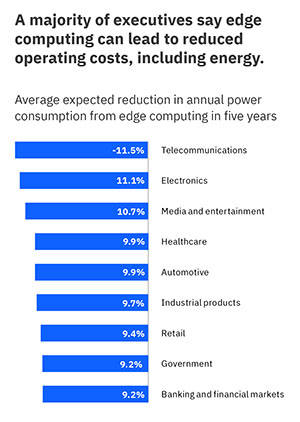Smarter Strategies
Insights and best practices for digital transformation
Edge Computing: Driving Operational Responsiveness Amid COVID-19 and Beyond
By Skip Snyder, Senior Partner, Global Intelligent Connected Operations Leader, IBM GBS
As the world moves through the COVID-19 pandemic, organizations across industries are accelerating their digital transformations and looking to technology to help them adapt in a new normal where disruption could be around every corner.
One enabling technology that many are taking into consideration is edge computing. Edge derives its name from the ability to take advantage of processing power, increased bandwidth and AI at the “edge” of the network, where data is captured and actions are taken, rather than transmitting large volumes of data to a cloud or on-premises data center for processing.
A recent IBM Institute for Business value study of 1,500 executives globally found that a growing number of leaders already see the value of edge computing, with 91% of respondents expecting their organization to implement edge computing within five years.
Executives surveyed cite numerous benefits from edge computing capabilities, but one of the most critical areas, especially for this moment, is operational responsiveness.
Responsiveness amidst uncertainty
Real-time data processing at the edge allows businesses to get more immediate insights from connected devices and systems. The ability to analyze data at its source allows businesses to make decisions and take action based on the most current data at any point in time. And in the midst of COVID-19, where business conditions are constantly shifting, operational responsiveness is essential.
According to research from the IBM Institute for Business Value (IBV), 84 percent of executives expect edge applications to positively impact operational responsiveness within the next five years. And that edge-induced responsiveness can lead to significant business benefits. A majority of respondents said edge computing will help them reduce operating costs and automate workflows in the next five years. What’s more, close to half expect edge capabilities to increase productivity and accelerate decision making.
 Imagine in industrial settings, such as a factory or plant, where edge computing combined with 5G could, for example, help manufacturers more quickly and efficiently enable automated machines and industrial robots to analyze data right on a facility’s floor.
Imagine in industrial settings, such as a factory or plant, where edge computing combined with 5G could, for example, help manufacturers more quickly and efficiently enable automated machines and industrial robots to analyze data right on a facility’s floor.
Looking ahead, edge, 5G and AI will enable businesses to take advantage of video and acoustic analytics that can detect and address potential problems on the spot. Video and acoustic analytics engines running on localized devices, for example, could be used to identify metal welds on an automotive manufacturing line that fail to meet quality standards, and immediately make algorithm adjustments to AI running on multiple machines to mitigate the problem.
The benefits of edge apply across many other industries as well. For example, in agriculture, sustainable agriculture companies could equip plants with IoT-enabled sensors and use edge computing to monitor the growth needs and ideal harvest time for individual plants. In retail, a retailer could use AI-infused edge applications to mitigate profit-sensitive issues like spillage, shrinkage and spoilage or to capture the full value of price adjustments based on traffic patterns, weather or other real-time variables. An automotive company could improve driver experiences through alerts and car-to-car communications.
And across industries, the combination of edge computing and industrial Internet of Things (IoT) devices has the potential to enable smarter supply chains, better equipping them to handle disruption of all kinds. As a result, an enterprise could leverage edge technology for asset performance management, providing a solution that collects readings from assets as they operate.
Edge has many benefits beyond operational responsiveness too, like energy efficiency. As more data is processed on the edge, less moves to and from the cloud, thus decreasing data latency and energy consumption. According to the IBV, over half of organizations plan to use edge computing applications for energy efficiency management within three years. And within five years, organizations across industries expect edge computing to decrease their annual power consumption by up to 11.5 percent, with those from telecommunications and electronics expecting the greatest decrease.
Looking ahead
As we continue to move into the new normal, more innovative uses of edge computing will emerge, both because and in spite of COVID-19’s impact on businesses.
Organizations will need to make the most of every advantage technology can give them as they adjust to operating in the uncharted territory the COVID-19 pandemic has created. The combination of edge computing, 5G and AI will create the opportunities they need to be responsive to the market and thrive amidst disruption.
→ Download the full IBV report, "Why organizations are betting on edge computing"